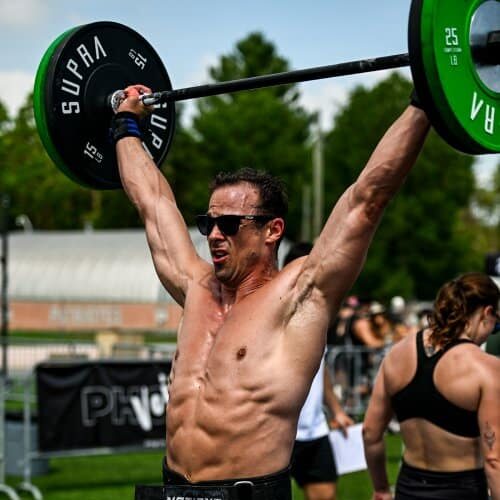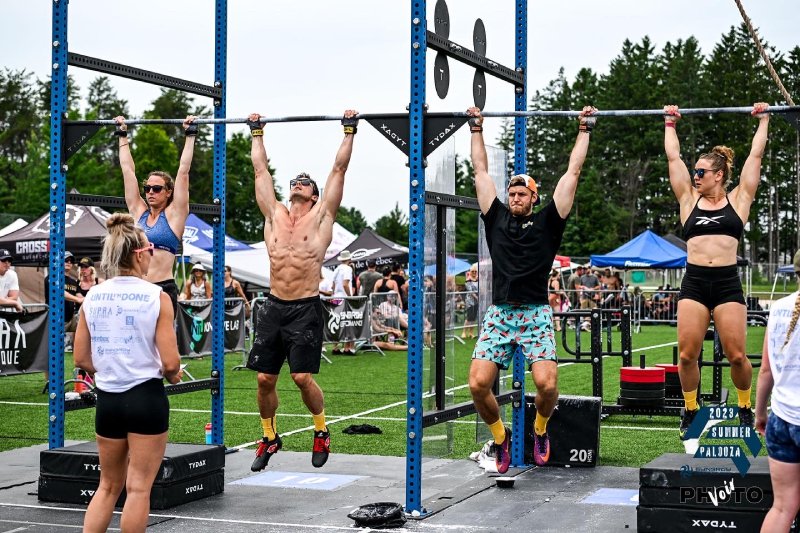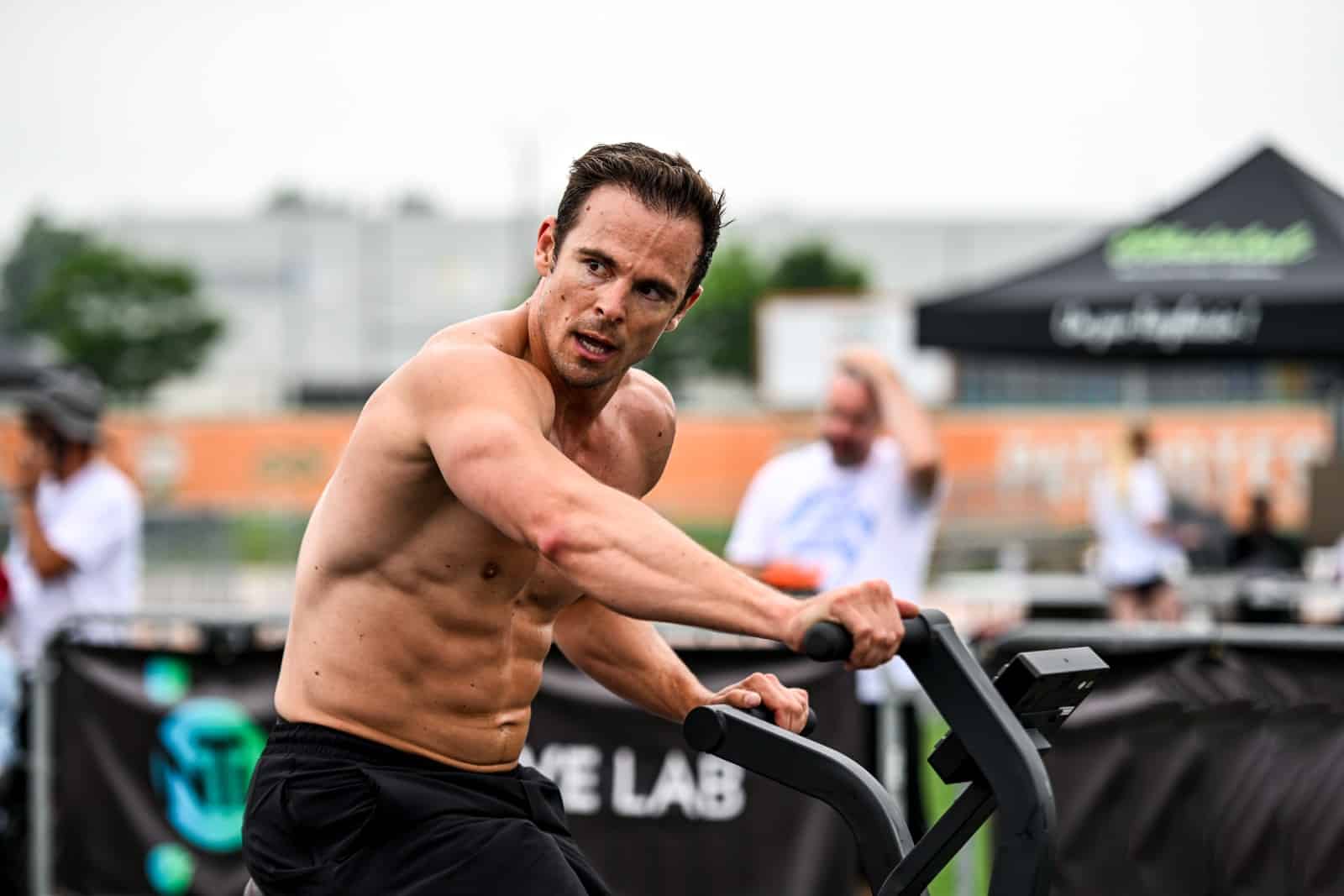Are you over 40 and finding that your body doesn’t respond to workouts the way it used to?
Today we dive into actionable strategies for setting realistic goals, including improving strength, fat loss, and mobility. Learn the essentials of crafting a balanced workout routine, from effective upper body exercises to lower body essentials, and how to integrate cardio for optimal heart health.
Plus, we dive into the significance of nutrition and recovery, ensuring your efforts in the gym pay off. Ready to redefine your fitness journey?
Jump to:
- First, a Word About Me
- Understanding Fitness After 40
- Setting Achievable Goals
- Essential Workout Strategies
- Strength Training Fundamentals
- Effective Upper Body Workouts
- Lower Body Workout Essentials
- Integrating Cardio and Conditioning
- Gym Equipment and Home Workouts
- Nutrition and Recovery
- Preventing and Managing Injuries
- References
First, a Word About Me

At 43, I can confidently say that I’m in the best shape of my life. I’m one of the oldest guys at my Crossfit gym and I still hold up to the younger kids.
So yes, you can get fit and strong after 40, you just need to be consistent (and patient).
Here’s how to get started:
Understanding Fitness After 40
For men over 40, maintaining fitness can be a different journey compared to your younger years. As you age, your body responds to exercise in distinct ways, and recognizing these changes is crucial for developing an effective fitness regimen.
The Importance of Strength Training
Strength training is pivotal beyond the age of 40. It’s not just about building muscle; it’s about preserving muscle mass and combating the natural decline that occurs with aging. Incorporating weights into your workouts a few times a week can help you maintain muscle strength and overall physique.
- Frequency: Aim for at least 2-3 strength training sessions per week.
- Intensity: Focus on moderate intensity to challenge your body while preventing injury.
Muscle Building Challenges
As you get older, building muscle can be more challenging due to natural hormonal changes and a slower metabolism. Understanding that gains might come more slowly than before is important to set realistic expectations.
- Patience is key: Celebrate small victories in strength improvement.
Benefits of Regular Exercise

Regular exercise goes beyond sculpting a strong body; it’s about enhancing your quality of life. With consistent effort, you can see improvements in:
- Bone density: Combating age-related bone density loss.
- Mental well-being: Exercise can be a powerful mood booster.
Adopting and sticking to a fitness routine that emphasizes these factors is vital in your 40s and beyond. It will support not just your physical health, but your overall well-being.
Setting Achievable Goals

When setting fitness goals, it’s essential to pinpoint realistic objectives in strength, fat loss, and mobility that reflect your capabilities and health status. Your goals should be specific, measurable, attainable, relevant, and time-bound (SMART).
Strength and Muscle Gains
Focusing on strength and muscle gains is not just about lifting heavier weights. It’s vital to recognize that over 40, your body responds differently to exercise. A practical aim could be to increase your current lifting weights by 10% within the next three months.
Coupling resistance training with adequate protein intake is key to achieving this. Aim for progressive overload, but also prioritize recovery to prevent injury.
Fat Loss and Conditioning
For fat loss and conditioning, set targets that create a sustainable calorie deficit without drastically cutting your food intake.
Initiatives like incorporating high-intensity interval training (HIIT) twice a week can boost metabolism and enhance conditioning. Remember that gradual fat loss leads to sustainable results; a realistic goal might be to aim for losing 1-2 pounds per week.
Improving Mobility
Enhanced mobility can significantly affect your quality of life. Designing a mobility plan that includes stretching and flexibility exercises for at least 20 minutes a day, four days a week, can create improvements.
You might set a goal to touch your toes comfortably or improve your range of motion in your shoulders and hips without pain.
Essential Workout Strategies
Crafting an effective workout strategy hinges on balancing exertion with recovery, ensuring you can build muscle and enhance fitness sustainably.
Balanced Workout Routine
Your workout routine should encompass a mix of cardiovascular, strength, and flexibility exercises. Aim for a split routine, dedicating specific days to different muscle groups to prevent overtraining and stimulate hypertrophy.
Incorporate compound movements like squats and deadlifts for maximum efficiency, and tailor your exercise experience to gradually increase intensity.
- Cardiovascular Training: 2-3 days per week
- Strength Training: 2-4 days per week, focusing on major muscle groups
- Flexibility Training: Daily stretching or yoga for improved mobility
Warm-Up and Recovery
Before diving into your routine, a proper warm up is crucial. Spend at least 5-10 minutes on dynamic stretches or light cardio to prime your muscles. For recovery, develop a cooldown ritual that includes static stretching and possibly foam rolling to aid muscle repair.
- Warm-Up Example:
- Arm circles
- Leg swings
- Light jogging
- Recovery Techniques:
- Static stretches, hold for at least 30 seconds
- Foam rolling, targeting tense areas
- Adequate hydration and nutrition post-workout
Strength Training Fundamentals
When embarking on strength training, especially for men over 40, it’s crucial to focus on proper technique, progressive overload, and a balanced approach combining both compound and isolation exercises. These elements help you build muscle effectively and safely.
Compound Movements
Compound movements involve multiple muscle groups and joints, making them efficient for building overall muscle strength and size. You should include exercises such as squats, deadlifts, and bench presses in your routine. They are beneficial for stimulating significant hormonal responses that aid muscle build and strength gains.
- Squats: Work the quads, hamstrings, glutes, and lower back. Keep your feet shoulder-width apart and back straight.
- Deadlifts: Target the back, glutes, and legs. Ensure your back is neutral and hips hinge properly.
- Bench Press: Focuses on chest, triceps, and shoulders. Use a controlled motion and avoid arching your back excessively.
Isolation Exercises
Isolation exercises target a single muscle group and are essential for addressing muscle imbalances and focusing on specific muscle development. Incorporate movements like bicep curls and triceps extensions to isolate and enhance individual muscles.
- Bicep Curls: Stand with feet hip-width apart, curling the weight while keeping elbows close to the torso.
- Triceps Extensions: Use a dumbbell or cable machine to focus solely on the triceps, keeping your core engaged and movement controlled.
Program Variation
Varying your workout program prevents plateauing and overuse injuries, and it’s a fundamental aspect of successful programming. Alternate the intensity, volume, and types of exercises you perform over time to continuously challenge your body.
- Intensity: Modify the amount of weight and number of reps. High weight with lower reps for strength, and lower weight with higher reps for endurance.
- Volume: Adjust the total number of sets and reps per workout. More sets can be used for hypertrophy, while fewer sets can suffice for maintenance.
- Exercise Type: Rotate through different exercises that target the same muscle groups to enhance technique and ensure balanced development.
Effective Upper Body Workouts
Tailoring your workout routine to effectively target the upper body is essential to gaining strength and building muscle after 40. Your workouts should be balanced, with exercises that systematically stress each muscle group to induce growth and increase strength.
Chest and Triceps
To develop your chest and triceps, incorporate the bench press as a foundational exercise. Aim for 3 to 4 sets of 8 to 12 reps, adjusting the weight to maintain good form while still challenging your muscles.
Follow up with pushups, which you can scale according to your fitness level, starting with 3 sets of 10 to 15 reps.
- Bench Press:
- Intensity: Moderate to heavy
- Repetitions: 8-12
- Sets: 3-4
- Pushups:
- Repetitions: 10-15
- Sets: 3
Back and Shoulders
For your back and shoulders, the overhead press is an excellent compound movement that targets multiple muscles simultaneously. Start with 3 sets of 8 to 10 reps, focusing on strict form.
Follow this with the lat pulldown, which not only targets the lats but also involves the biceps and rear deltoids. For the lat pulldown, 3 to 4 sets of 12 reps are ideal to sculpt the upper body.
- Overhead Press:
- Intensity: Moderate
- Repetitions: 8-10
- Sets: 3
- Lat Pulldown:
- Intensity: Moderate
- Repetitions: 12
- Sets: 3-4
Arm Focused Exercises
Lastly, to define your arms, isolation exercises should be the focus. Bicep curls and tricep extensions, performed in alternating sets, can effectively stimulate arm growth. Start with bicep curls using dumbbells for 4 sets of 12 reps, before moving on to tricep extensions for another 4 sets of 12 reps.
- Bicep Curls:
- Intensity: Moderate
- Repetitions: 12
- Sets: 4
- Tricep Extensions:
- Intensity: Moderate
- Repetitions: 12
- Sets: 4
Lower Body Workout Essentials
When designing lower body workouts, the focus is on compound movements that target the major muscle groups, such as the quadriceps, hamstrings, calves, and glutes, to ensure a balanced development and maintain functional strength.
Quadriceps and Hamstrings
Your quadriceps, located at the front of your thighs, are pivotal for knee extension and overall leg power. Effective exercises to target this muscle group include the leg press and leg extension.
Start with the leg press to engage multiple muscles, pressing the weighted platform away from your body with your feet flat. For leg extensions, perform them on a machine by lifting the weight with your ankles against the padded bar, focusing on controlled movements.
For your hamstrings, which run along the back of your thighs, the leg curl is an indispensable exercise. You can perform leg curls lying, seated, or standing, depending on the equipment available, curling the weight toward your buttocks to engage your hamstrings fully.
- Leg Press: 3 sets of 8-12 reps
- Leg Extension: 3 sets of 8-12 reps
- Leg Curl: 3 sets of 8-12 reps
Calves and Glutes
Strong calves contribute to ankle stability and propulsion. The calf raise is a simple yet effective exercise to strengthen your calves. You can perform it on a step or a dedicated machine, raising your heels as high as possible before lowering them below the level of the step or platform for a full stretch.
For your glutes, consider exercises like squats and bridges. However, for a targeted glute workout, you should incorporate hip thrusts, which directly recruit the glute muscles as you lift and lower your hips while your shoulders are typically supported on a bench.
- Calf Raises: 3 sets of 15-20 reps
- Glute-focused Hip Thrusts: 3 sets of 10-15 reps
Integrating Cardio and Conditioning
Integrating cardio with conditioning is essential to maintain heart health and muscular strength. A balanced regimen can help you achieve optimal fitness results while minimizing the risk of injury.
Running and Endurance
You can enhance your cardiovascular fitness through steady-state activities like running. To start, aim for a brisk 30-minute run at a comfortable pace, three times a week.
The goal is to gradually increase your endurance, which is the cornerstone of a solid cardio foundation. Monitor your heart rate to ensure you are working within the right intensity zone for maximum benefit.
High-Intensity Interval Training
For conditioning, incorporate High-Intensity Interval Training (HIIT) into your routine twice a week. Alternate between short bursts of intense activity, such as sprinting or jump squats, with equal or longer periods of rest. For instance:
- Sprint: 30 seconds
- Rest: 90 seconds
- Repeat: 5–10 times
This approach not only boosts your cardiovascular fitness but also promotes fat loss and muscle maintenance. With HIIT, you’ll get a challenging workout in a shorter period.
Gym Equipment and Home Workouts
When considering fitness after 40, you have a variety of gym equipment options that can fit into your home workout routine. Whether you opt for machines or free weights, ensure proper form and tailor your workouts to your fitness level.
Machines vs Free Weights
Machines offer guided movements, reducing the chance of injury and making them a safe option if you’re new to strength training or have specific limitations.
For example, resistance machines provide a controlled motion, isolating specific muscles and helping with balanced development. On the other hand, free weights like dumbbells and barbells involve more stabilizing muscles and can lead to greater functional strength gains.
Make your choice depending on your fitness goals, space, and budget.
- Machines: Safety, ease of use, targeted muscle groups
- Free Weights:
- Pros: Enhance stabilizing muscles, versatility, functional strength
- Cons: Require more technique, higher injury risk without proper form
Building a Home Gym
To set up a home gym tailored for men over 40, focus on acquiring key pieces of equipment.
Start with a set of dumbbells; they are versatile and can be used for a wide range of exercises. Incorporate a bar with weight plates for progressive overload and strength training. If space and resources allow, consider adding a bench and a multi-purpose resistance machine for a well-rounded regimen.
Remember, consistency is key, and less can be more when each piece of equipment serves multiple fitness purposes.
- Essential Equipment:
- Adjustable dumbbells
- Barbell and weight plates
- Workout bench
- Resistance bands or machine
Arrange your equipment to create an inviting workout space that motivates you to stay consistent with your fitness routine.
Nutrition and Recovery
Proper nutrition and recovery are crucial for men over 40 engaging in workouts, as they greatly influence muscle gain and the body’s ability to repair itself after exercise. A balanced diet rich in protein and adequate rest are pivotal to ensure effective muscle-building and recovery.
Diet for Muscle Gain
The foundation of your muscle-building journey is a diet that supports and enhances your workout efforts.
Incorporating a high-protein intake is essential, as proteins are the building blocks of muscle. Sure sources of protein include lean meats, fish, eggs, and dairy products. It’s recommended to consume between 1.3 to 1.6 grams of protein per kilogram of body weight daily to support muscle synthesis and recovery.
Pair this with complex carbohydrates like brown rice or quinoa and healthy fats such as those found in avocados and nuts. These nutrients provide the energy needed for workouts and assist in the recuperation process.
Key vitamins and minerals from fruits and vegetables should also be included to aid metabolic processes vital for muscle repair.
- Sample High-Protein Food Sources:
- Lean Meats: Chicken breast, turkey, lean beef.
- Fish: Salmon, tuna, mackerel.
- Legumes: Lentils, chickpeas, black beans.
- Dairy: Greek yogurt, cottage cheese, milk.
Importance of Rest and Sleep
Sleep is not merely downtime; it’s a vital part of the recovery process. During rest, your body produces hormones like growth hormone, which is integral to muscle repair and growth.
Aim for 7-9 hours of quality sleep per night to ensure that you are giving your body enough time to recover. During sleep, muscle tissues damaged by weight training are repaired and strengthened. Moreover, adequate rest can boost your immune system, improve cognitive functions, and reduce the risk of overtraining, which becomes increasingly important as you age. Remember, rest days are as significant as workout days.
Schedule them into your routine to allow your muscles to recuperate and come back stronger.
- Sleep and Rest Recommendations:
- Prioritize 7-9 hours of uninterrupted sleep.
- Create a relaxing bedtime routine to enhance sleep quality.
- Include rest days in your workout schedule to prevent overtraining.
Preventing and Managing Injuries
It’s crucial to prioritize injury prevention and management. By employing safe workout techniques and understanding how to deal with common injuries, you can maintain your fitness without setbacks.
Safe Workout Techniques
To minimize the risk of injury, it’s essential to practice safe workout techniques. Begin with a thorough warm-up to prepare your muscles and joints for exercise. Emphasize proper form in every exercise, which often means engaging your core, aligning your spine, and avoiding jerky movements.
Consider incorporating balance and flexibility training to support muscular coordination and prevent falls. Research suggests that strategic prevention can be effective against injury, especially in mature adults who are more susceptible to accidents due to decreased bone density and muscle strength.
For instance, techniques that focus on balance and flexibility can reduce the likelihood of falls.
Dealing with Common Injuries
If you do sustain an injury, it’s important to respond promptly and appropriately. Common injuries such as strains and sprains require immediate rest. Apply ice to reduce swelling and consider compression to support the injured area. Elevate the limb if possible to minimize bruising and discomfort.
Taking sufficient time to recover is vital, even if the injury seems minor. Should you experience joint pain, it might be indicative of overuse or arthritis, both of which are more common as you reach maturity.
It’s imperative to consult with a healthcare professional who specializes in men’s health for a proper diagnosis and tailored recovery plan. Knowledge of exercise modifications can also aid in managing chronic conditions and prevent further injury during your workout routine.
References
- https://pubmed.ncbi.nlm.nih.gov/8133731/
- https://karger.com/ger/article-abstract/62/1/22/148222/The-Osteogenic-Effect-of-Impact-Loading-and?redirectedFrom=fulltext
- https://www.ncbi.nlm.nih.gov/pmc/articles/PMC9457363/
- https://academic.oup.com/ageing/article/35/suppl_2/ii37/15775
- https://diabetesjournals.org/care/article/33/12/e147/39268/Exercise-and-Type-2-DiabetesThe-American-College















